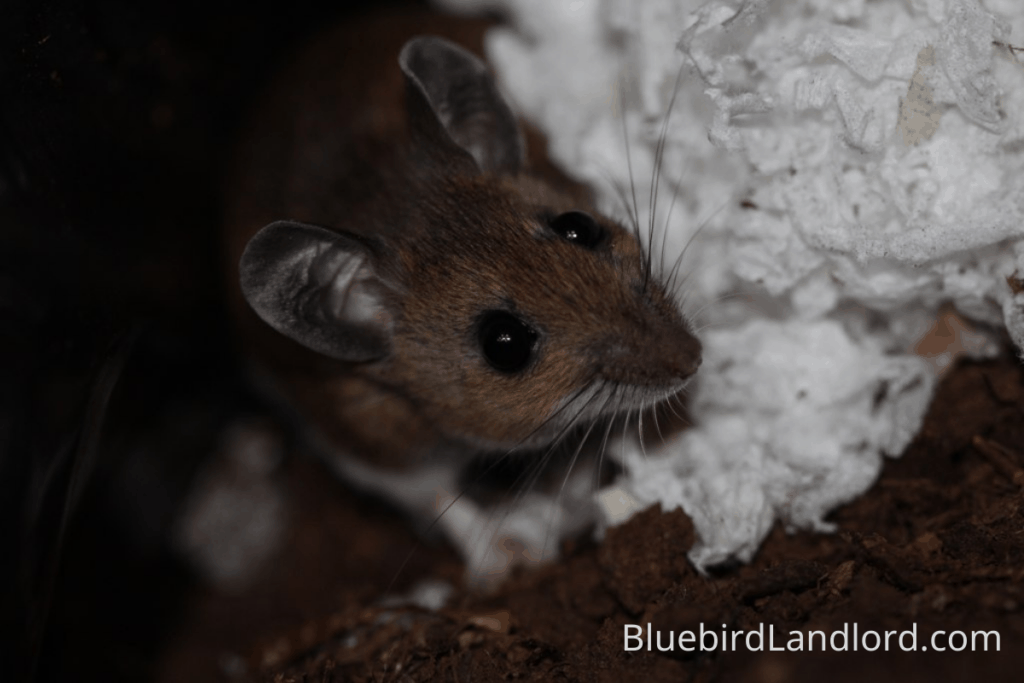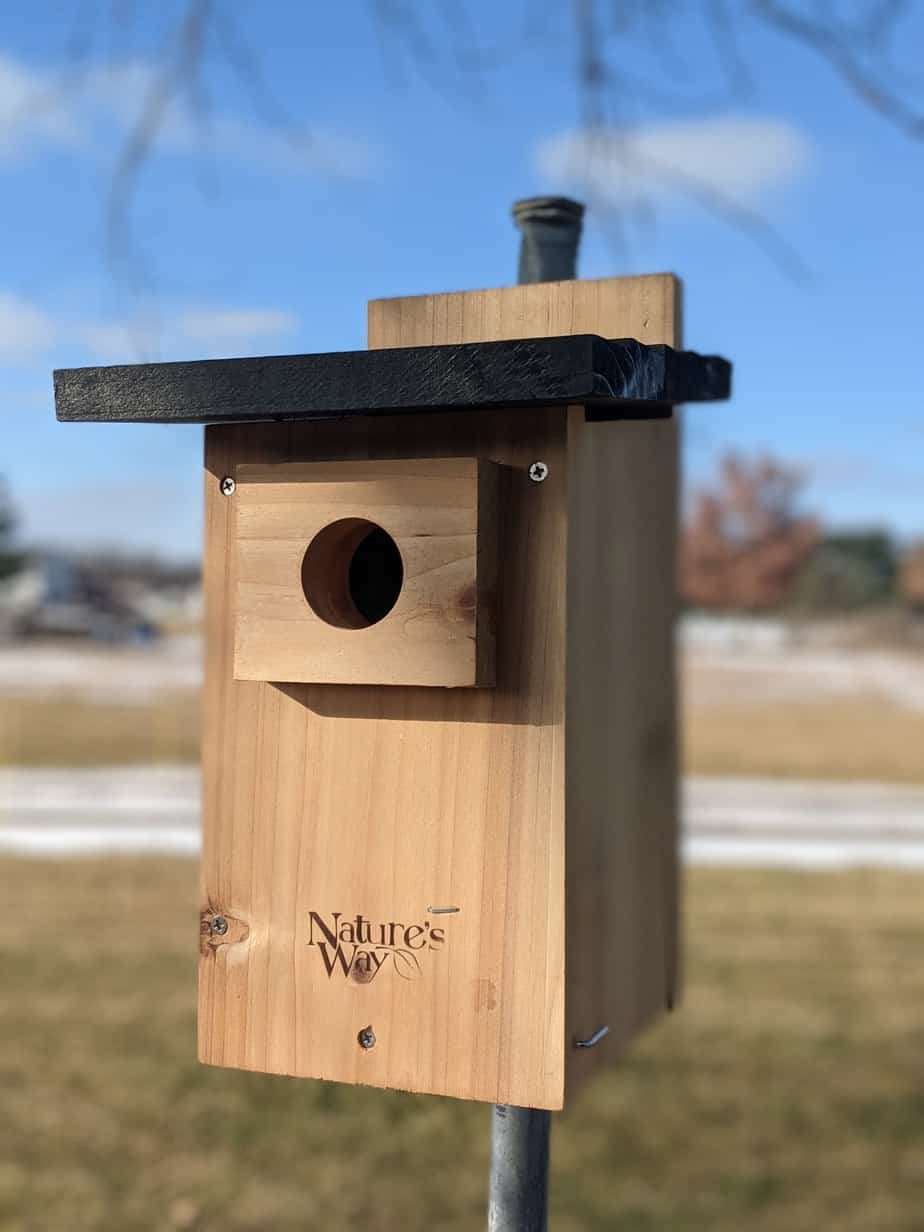
When you think about animals that can break into bluebird houses, you might think of raccoons, cats, snakes, and squirrels. But, mice can also cause big problems for bluebirds. Mice can slip into bluebird nest boxes, build nests, and cause damage to the nest box and to young bluebirds. If you’re wondering how to keep mice out of your bluebird houses, here’s the quick answer for what you can do:
To keep mice out of bluebird houses: (1) mount the nest box on a metal pole, (2) keep the nest box away from large rocks and bushes, (3) install a predator baffle on the nest box pole, (4) remove mice nests whenever you find them, and (5) deter mice with mint leaves or peppermint oil.
In this article, I’ll explain why mice are a problem for bluebirds and I’ll go through each of these five deterrent methods in more detail to talk about why they are effective.
The photo above by alsteele is licensed under CC BY-SA 2.0.
Why are Mice a Problem for Bluebirds?

Photo by J. N. Stuart is licensed under CC BY-NC-ND 2.0
Mice that access bluebird houses are a problem because they drive bluebirds away and damage their eggs. They also pose a sanitation problem by urinating in the nest box and carrying diseases.
Mice Create Unnecessary Competition for Bluebirds
When mice enter an active bluebird house, for example, they like to build their nests on top of the bluebird nest. In doing this they drive the bluebirds away. They also break bluebird eggs by smashing or eating them. Bluebirds already deal with House Wrens and House Sparrows destroying their eggs and competing with them for nest boxes, they shouldn’t have to compete with mice too.
Mice Carry Diseases and Make a Mess
If mice access an inactive bluebird house, during the winter or anytime bluebirds aren’t using it, the biggest concern is sanitation of the nest box. First of all, mice tend to leave a urine-soaked mess in nest boxes, making them very difficult to clean. Also, deer mice have been known to carry hantavirus, a lung disease that can be fatal to humans (source). Although rare, this disease should be taken seriously and mice should be kept out of your bluebird houses as much as possible.
So, now that we know mice can be a serious problem for bluebirds, here’s what you can do to keep them away.
How to Keep Mice Out of Bluebird Houses (5 Methods)
1. Mount the Nest Box Properly on a Metal Pole

Mice are very good climbers, so mounting your bluebird house on a wooden post or attaching it to a tree is one of the best ways to invite mice in. Instead of mounting your nest box on a wooden post, mount it on a metal pole to keep mice, as well as other climbing predators, from climbing up and accessing the nest box.
The North American Bluebird Society recommends using a 1/2 inch electrical conduit pole for mounting your nest box (source). These poles work really well and they are usually coated with zinc to prevent corrosion, so they last a long time. You can get a pole like this from almost any hardware store. Here’s a link to one from Home Depot.
You can also get a commercial “bluebird house pole set” that comes with a metal pole and everything you need to mount your bluebird house to that pole. While this is a more expensive option, if you’re not good at DIY, this might be the easiest way for you to mount your nest box. Here’s a Bluebird House Pole Set that other Bluebird Landlord readers have purchased from Amazon.
2. Keep the Nest Box Away from Large Rocks and Bushes
Even if your bluebird house is installed correctly on a metal pole, mice can still jump up and access the nest box if there are large rocks and bushes located under or around it. So, to keep mice out of your bluebird houses, mount nest boxes away from large rocks and bushes.
If your nest box is already mounted close to rocks or bushes that are a permanent part of your yard’s landscape, move the nest box to a different location. Typically, just moving the box 5-10 feet away will do the trick. However, if there is an active bluebird nest in the nest box, wait to move the nest box until after the baby bluebirds have fledged.
3. Install a Predator Baffle on The Nest Box Pole

Your next line of defense against mice is a a predator baffle. Sometimes, even if your nest box is in a good location, and mounted on a metal pole, mice will still find their way into the box. Installing a stovepipe-style predator baffle on the pole is a great way to keep mice out of your bluebird house.
A stovepipe-style baffle is a common tool that many bluebird landlords use on their bluebird trails. These devices are great at keeping raccoons, cats, and other climbing predators from accessing the nest box. Plus, they also work for mice!
You can build a stovepipe-style predator baffle yourself with these DIY plans here from Sialis.org. Alternatively, you can buy a ready-made baffle from a good retailer. See the one I recommend on my Recommended Tools page here.
4. Remove Mice Nests Whenever You Find Them

Photo by Jane Kirkland is licensed under CC BY-NC-ND 2.0
If you ever find a mouse nest in your bluebird house, you need to remove it immediately. If the mice build a new nest, remove that one too. You need to remove mice nests whenever you find them in your bluebird houses. This will encourage persistent mice to find a new home and will keep your nest box a safe place for bluebirds.
If you ever find a mouse nest in your bluebird house, you need to remove it immediately. If the mice build a new nest, remove that one too. You need to remove mice nests whenever you find them in your bluebird houses.
bluebirdlandlord.com
How to Identify a Mouse Nest in a Bluebird House
A typical deer mouse nest is made of grasses, leaves, bark, cotton, cloth, and other various materials. It will appear fluffy and messy, and unlike a bird nest, it probably won’t have a nest cup. You might find it in an empty bluebird house during the winter, or on top of an active bluebird house during the nesting season.

How to Remove a Mouse Nest from a Bluebird House
To remove a mouse nest safely from a bluebird house, the University of New Mexico recommends you first spray down the nest and nest box with a bleach solution to avoid contracting hantavirus and other diseases (source). Mix 1 1/2 cups bleach with one gallon of water and spray the nest and nest box. Then, wait a minute for the dust and debris in the box to become wet. After that, remove the mouse nest with a gloved hand and dispose of it away from the nest box. This procedure will diminish the risk of you breathing in dust from the nest, and it will sanitize the nest at the same time.
How to Clean a Bluebird House After Removing a Mouse Nest
Once you remove the mouse nest from your bluebird house, you’ll need to properly sanitize the nest box for bluebirds. Using the same bleach solution that you created earlier (1 1/2 cups bleach to one gallon of water) spray the floor, sides, and interior door of the nest box with the bleach solution. Then, wait 15 minutes for the solution to soak in, and wipe out the box with a clean cloth. Now, spray the nest box again, open the door and let the nest box dry out for at least 24 hours. Once the nest box has dried out for a day, you can close it up and it should be sanitized and ready to be used again by bluebirds.
If you seem to be doing all of the right things, and mice continue returning to your bluebird house, there’s one more thing you can try.
5. Deter Mice with Mint Leaves or Peppermint Oil

Photo by zehawk is licensed under CC BY-NC-ND 2.0
Mice and other rodents are overwhelmed by the smell of mint. So using natural mint and/or peppermint oil can be an effective way of deterring mice from your bluebird house.
If you have mint leaves available in your garden, rub a few leaves on the inside of your bluebird house. The natural oils will soak into the wood and (ideally) keep mice away. Repeat this process every few days to keep the mint smell fresh. You can also achieve the same effect with peppermint oil, and it might even work better since it has a more potent smell.
Apply five drops of 100% peppermint oil to a cotton ball. Then stick the cotton ball to the interior wall of your bluebird house with a thumbtack. The smell will permeate the nest box, but the elevated cotton ball will keep the peppermint oil away from young bluebirds, which could potentially be harmful to them. Just like with the natural mint, replace the peppermint-infused cotton ball every couple of days to keep the mint smell fresh.
Give this mint method a try if you’re having a particularly difficult time deterring mice from you bluebird houses. Here’s a link to some 100% Peppermint Oil on Amazon.
Conclusion: How to Keep Mice Out of Bluebird Houses
Mice can be a surprising and annoying problem to deal with when you’re trying to attract bluebirds to your back yard. But, hopefully with these five methods, you can keep mice out of your bluebird houses for good!
If you are looking for a new nest box for your bluebirds, check out my Recommended Tools page here to see the nest boxes, feeders, and other tools that I recommend for bluebirds.

